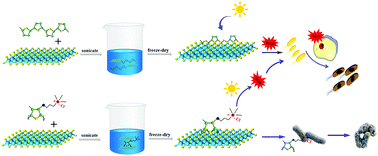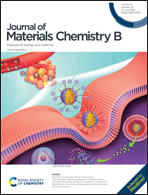Boosting the visible-light-driven photocatalytic antibacterial performance of MoS2 nanosheets by poly(3-(4-methyl-3′-thiophenoxy))propyltrimethylammonium chloride (PThM) modification†
Abstract
Molybdenum disulfide (MoS2) has been reported to possess photocatalytic bactericidal ability, but its efficiency is not high. In this paper, a water-soluble cationic conjugated polymer, poly(3-(4-methyl-3′-thiophenoxy))propyltrimethylammonium chloride (PThM), was designed to modify MoS2 and boost its antibacterial abilities. Another hydrophobic conjugated polymer, polythiophene (PTh), was synthesized and composited with MoS2, and this was compared with PThM/MoS2 from the perspective of composite effectiveness. Studies involving the photo-disinfection of Escherichia coli (E. coli) under visible-light irradiation (30 W) showed that the antibacterial efficiencies were in the following order: PThM/MoS2 > PTh/MoS2 > MoS2. The enhanced bactericidal activities of PThM/MoS2 and PTh/MoS2 were attributed to the conjugated polymers restraining the recombination of photogenerated carriers in MoS2, thereby increasing the generation of reactive oxygen species (ROS). PThM/MoS2 presented the best antibacterial efficiency because its cationic side-chains improved the solubility of the material and promoted contact between bacteria and the material. This work may provide some insights into the design of practical nano-antibacterial materials.



 Please wait while we load your content...
Please wait while we load your content...